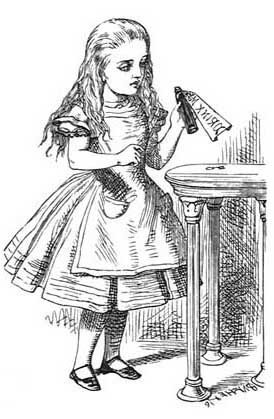Alice’s Adventures in Wonderland
“round the neck of the bottle was a paper
label, with the words `DRINK ME' beautifully printed on it in large letters.”

Alice attention is caught by the big letters on the
bottle that says DRINK ME and the letters on the box, EAT ME. For a child it is perhaps
easier to read when something is labelled in big letters. In Roald Dahl’s George Marvellous Medicine the form of having the ingredients written in big letters might indicate that the DRINK ME and EAT ME in Alice’s
Adventures in Wonderland are also ingredients, which in this case transform a child’s wish
into reality. When Alice wants to become smaller she magically becomes smaller
by drinking from the glass bottle and when she desires to become taller she becomes
taller by eating the cake from the glass box. This seems similar to Cinderella's glass slipper, which was created by one wish and some magic. Cinderella only get one chance
with her wish… So, it makes sense to believe that Alice also only gets one wish
for each magical item. This happens before she goes into the desired
garden which makes it thinkable that she is setting up the rules for the food
before she ventures in to the unknown. If that is the case, then like everything else in wonderland this is too
turned upside down. The next time she drinks from the bottle DRINK ME she
becomes taller again and when she eats the cake she become smaller. A curious
thing is it not?
The food is according to Alice palatable,
especially the drink which had a “mixed
flavour of cherry-tart, custard, pine-apple, roast turkey, toffee, and hot
buttered toast,) she very soon finished it off.” She consumes it quickly as
she is assured by the taste that it is not poisonous. The drink seems to have a colourful taste; the cherry –tart is red and is a
homemade dessert, pineapple is yellow and is an exotic fruit, roast turkey is
nutritional and it is usually remembered as a holiday meal, toffee is brown and
sugary, and at last hot buttered toast is soft and warming. I can imagine this
being very tempting to drink, because it is several meals in one. What a luxury!

Her transformation is in a way dimensional because the
change in her size allows her to enter a new universe. It is also a magical transformation.
When she transforms into a taller version of herself it gives the other characters
like the rabbit a fright, he runs away when he sees her in her giant form. This
frequent transformation is messing with her mentally which makes her cry, this
can relate back to reality of a child feeling frustrated about experiencing a
bodily change. The next time the rabbit sees her after a transformation he is
not alone so he is no longer afraid, but sees her as a problem. Her third
change is when she meets the caterpillar who gives her another chance of transforming, this time so she can go back to her natural form.
““One side will make you grow
taller, and the other side will make you grow shorter.”
“One side of what? The other side of what?” thought Alice
to herself.
“Of the mushroom,” said the Caterpillar”
The mushroom bits create the quickest and strangest
transformation up to this point. By eating some of the first mushroom bit her
neck extends until she looks like a serpent, which seems dangerous but she
quickly retreats by nibbling at the other bit which lowers her down to a normal
size which suddenly makes her safe once more. It is not until she is her normal, perfect size that she can get back to finding
the beautiful garden and entering it. Suppose food is here just time consuming.
The time lost by the turmoil of changing all the time takes Alice away from the
garden, away from her desired goal. So food seems to create loopholes in this world,
but it also distracts her and puts her in danger.
- The End -
Carroll, L. Alice’s
Adventures in Wonderland. 1865











